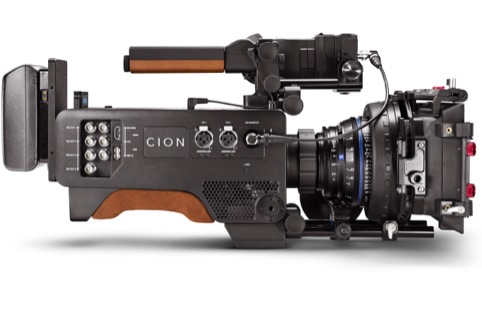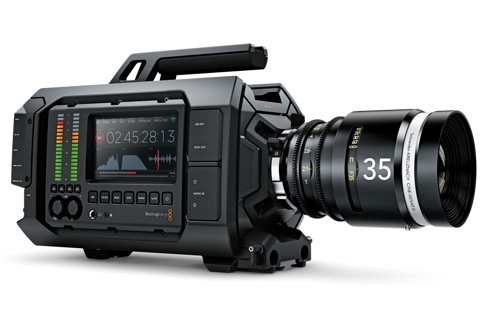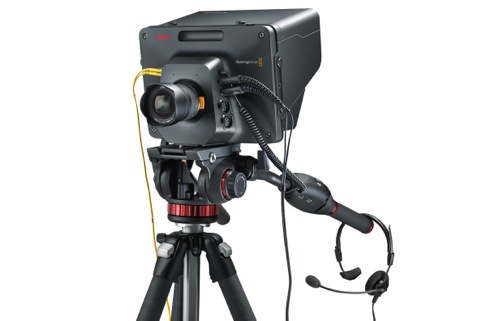
The rash of affordable 4K cameras and the ease of set to post workflow will make Ultra HD an attractive origination format for producers.
Ultra HD broadcasts are inevitable and while there are serious debates to be had about the exact calibration of pixels, frame rate and dynamic range that will pique consumer interest, there’ll soon be no shortage of ways to produce it.
NAB was all about the affordability of 4K and the ease of set to post workflow. Landing most column inches once again, as much for the nonchalant presentation of CEO Grant Petty (pictured) as for the wave of products announced at unfeasibly low prices, Blackmagic Design underscored the can-do attractiveness of 4K production.
Tempting price points from Blackmagic
Blackmagic is releasing four new 4K cameras, including two URSA Super 35 models for feature film (with EF and PL mount), another similarly specced unit for broadcast featuring a B4 mount, and a Studio Camera for live production.

Explaining that one of the problems with live production is that most cameras have not really been designed for the job, Petty said: “They don’t have the features that we need, such as a large bright viewfinder, talkback, tally or optical fibre plus almost all cameras are made from plastic.”
BM’s model takes care of all that, is cast from tough magnesium, features an active Micro Four Thirds lens mount to swap between ENG and higher quality lenses and has 12G-SDI connectivity which can route signals over a single fibre. That’s important because the company has updated its ATEM switcher to allow full control of this camera. It also bundles in a copy of the DaVinci Resolve colour grading software for good measure.
“We included a four-hour battery so it can work remotely at a live event where there’s no power connection so users can take the camera closer to the action,” added EMEA sales director Simon Westland. “We’ve miniaturised many of the functions but one we didn’t was the viewfinder. The 10-inch LCD is on the same axis as the lens, rather than having a monitor off-set, above or to the side of the camera. When you look down the viewfinder you are directly behind the lens, so while it’s a very compact unit in all other aspects, it feels huge when you are behind it.”
An HD version of this camera is already shipping with the £1800 Ultra HD version due in June, available like the rest of Blackmagic’s range direct from the vendor. Although the price-point is tempting, proof as always will be in the willingness of cinematographers and producers to lens shows with them. Westland says all its cameras have gone through secret testing with users and that a number of high-profile projects are currently shooting with its cameras.
Blackmagic reverse engineered a camera product line based on its expertise in capture and playback devices.
AJA finds a gap in the market
That’s the same route taken by AJA which said its Cion 4K camera began life in the labs four years ago and has finally come to market now that it has developed the right sensor.

“Having a sensor is just the beginning,” said product manager Bryce Button. “The real work is in the colour science behind it.” It’s rich colour settings will appeal to feature and commercials producers while its ENG style ergonomics will find favour with documentarians, reckons Button.
“In terms of non-traditional hardware companies moving into cameras, [Blackmagic] indicated that we could be successful,” he admitted, although another motivation was a gap in the market for an inexpensive, high-quality imager that felt more like a conventional production camera, less like a DSLR.
“High end feature films are probably best served by the Sony F65 but then it costs 10 times as much,” he said. “For the majority of work from indie films to docs and corporate we are trying to design a camera that doesn’t cost a fortune with all the workflow needs and quality people are looking for.”
It offers in-camera recording directly to the Apple ProRes family of codecs – including the 12-bit 444. Available this summer, it can record directly to AJA Pak SSD media at up to 60fps and offers raw 4K data in a AJA file format which the company says will be opened to anyone, at 120fps via 3G-SDI.
Involved in ProRes encoding for a decade, AJA has already monetised the R&D in this area, it says, so it does not have to pass this cost on and is one reason for its low price. At £5400 Cion underlines how far down the price curve 4K is compared to HD at this point in its rollout.
Atomos’ 4K debut
Who knows, maybe next year fellow capture card experts Atomos will have brought out its own 4K imager. It was content this year to release its first 4K product, the 7-inch Shogun 4K monitor and HDMI recorder, which works with Sony’s revamped A7S DSLR, outfitted with a 12.2 megapixel 35mm CMOS sensor for 4K video. What sets the product apart from the competition is its ability to use the entire width of a full-frame image sensor when shooting Ultra HD, said Sony.

The A7S is compatible with E-mount lenses, and it can also be used with A-mount and others lens systems with optional adapters and is also shipping later in 2014; pricing was not announced.
Arguably the more significant announcement from Sony is that its F55 and F5 units can be used in run and gun mode by way of a shoulder-mount kit. Features include a sliding shoulder pad, an audio-control panel, and a wireless-audio-receiver slot. Sony has first mover status in 4K live production and has already gained considerable knowledge of workflows for its cameras and production servers in application from theatre to sports and even Papal ceremonies. While companies like AJA and Blackmagic are still run by their founders and seem capable of unleashing groundbreaking product at will, the decision-making at traditional manufacturers can seem like turning around a tanker in a canal.
The 4K heavyweights
NAB however showed signs of fight back from heavyweights like Panasonic, which previewed (once again) the VariCam 35 incorporating its AVC-Ultra codecs but this time with support from Codex Digital to deliver a 4K 120fps uncompressed RAW recorder. Due to market around IBC the VariCam is for cinema, commercials and episodic production with a £35K pricetag.
JVC revealed a quartet of 4K prototypes built from IP obtained from CMOS sensor developer Altasens it acquired in 2012 from Olympus. These included a mini-cam with a target price of £2500; the shoulder-mounted Elise (target price £10k); and a gimbal-mounted version co-developed with NHK (target price £15k). The latter kit cannot only shoot from aerial drones but stream the live video to the ground, useful for coordinating movie shoots.
“We’ve been speaking to [broadcast] networks who have been requesting handheld handycam type products with a large imager,” said marketing manager Craig Yanagni. “This is precisely what we’ve been targeting with this design concept.” And concept they remain with JVC coy on commercialisation. “If demand is greater, the products will come sooner,” said Yanagni.
Injected with £15m of Belden’s cash, Grass Valley heralded its NAB as ‘Future Ready’ and announced a 4K version of its outside broadcast stalwart LDX replete with three-chip sensors, rather than one.
“4K production has been based on cameras that are really designed for film with PL-mount lenses, posing some difficulties with depth of field and the amount of zooming you can do and sensitivity loss if you had to mount B4 lenses,” outlined Grass Valley’s marketing chief Mike Cronk. “This is the first technology showing of a native-4K LDX camera with a B4 lens.”
Outside broadcasters eager to equip with 4K shooters still only have one option though – Sony – since Grass Valley declined to say when these cameras will be ready, although they are being trailed.
Lacking the volume of erstwhile leader of the rebellion Ted Shilowitz, now hoping to change the way Hollywood thinks about computing at chip developer Devil & Demon, Red Digital Cinema still made noise with 4K broadcast functionality for its Epic and Scarlet cameras. The £4000 module uses four 3G-SDI connections to broadcast 4K video at up to 60fps. Orders are being taken for the £9k Scarlet Dragon camera, due in June, which can capture 6K at 12 fps, 5K at 30fps or 4K and HD at 48fps.
By the end of the year then there will be a plethora of options for producers of drama, docs, sports and studio-based live shows to capture in Ultra HD. You don’t have to scratch too far beneath the surface though to find those arguing that resolution is not enough.
HDR: the game-changer
At NAB’s digital cinema summit, Richard Welsh (pictured), a SMPTE governor for EMEA, said since digital cameras already capture at such high resolutions, pixel count just isn’t an issue for most creatives. High dynamic range (HDR) on the other hand does provide a big creative and aesthetic difference.

“Once you get to the point of displaying that content in the cinema or the home, you can present what you actually captured in the scene,” he said. “I think that’s a game-changer from creatives’ point of view.” However, Welsh said, HDR is difficult to explain and hard for people to envision until they’ve seen it. “The problem is, in order to sell that, consumers need a number they can understand, and they all understand pixel count. We know that from the camera industry, where they go for megapixels. But the numbers for HDR [measured in NITs, where 4000 NITs is a target against current displays of 400 NITs] aren’t the sort of numbers you can throw out to consumers to tell that story. The engineering and creative side of the industry understand HDR but it’s hard to sell.”
A notable exception to the 4K hoopla was Arri which failed to debut its higher than 2.5K resolution camera which it has admitted in the labs. Nonetheless, if anyone can crack the code which permits rich colour depth, high frame rates, high resolution and high dynamic range all in one camera package, bet on them.







